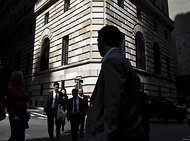 Seth Wenig/Associated PressThe Federal Reserve Bank of New York.
Seth Wenig/Associated PressThe Federal Reserve Bank of New York.
The Federal Reserve seems to be hoping that an ugly chapter in America’s economic history won’t repeat itself.
As part of the regulatory overhaul that took place after the financial crisis, the Fed now has to conduct annual stress tests of the banking system. In these tests, the central bank tries to assess whether the banks have the financial strength to get through some pretty dire conditions. On Thursday, the Fed outlined those circumstances, giving theoretical forecasts for things like economic growth, bond yields and house prices.
But there’s a certain type of dire possibility that the Fed doesn’t seem to want to contemplate: the sort of economic turbulence that affected the United States in the 1970s and 1980s. Back then, inflation would get out of control and the Fed would have slam on the economic brakes by hoisting key interest rates. An economic slowdown would ensue.
In its latest stress test documents, the Fed supplies a baseline case, an adverse situation and a severely adverse one. In the latter two, the Fed does envision a lot of nasty things. In the severe one, for instance, it assumes the unemployment rate exceeding 12 percent in early 2014.
But what the Fed doesn’t consider is the country’s cost of borrowing rising to the peaks seen during the 1970s and 1980s.
In the severe case, the yield on the 10-year Treasury note is at 1.2 percent during the theoretical slump. In the merely adverse case, the Fed assumes it goes as high as 4 percent during a putative recession that goes from the end of 2012 to the beginning of 2014. The 10-year Treasury yield exceeded 10 percent for sizable part of the 1980s.
Granted, high Treasury yields may be introduced in some form. The Fed said Thursday that in the next couple of weeks it will provide a “market shock” scenario, to be applied only by large banks with Wall Street operations. This will factor in “a broad increase in U.S.Treasury yields.”
It’s highly unlikely that runaway inflation will return any time soon, forcing interest rates back to 1980s levels. And if we start to move into an economy with higher inflation, the Fed can always adjust its stress tests to reflect that reality.
Still, stress tests are meant to capture the unexpected. Remember that housing crash hardly anyone foresaw? Perhaps there needs to be a fourth stress test possibility: the super severe retro recession.
Article source: http://dealbook.nytimes.com/2012/11/16/the-selective-memory-of-the-feds-stress-tests/?partner=rss&emc=rss
Speak Your Mind
You must be logged in to post a comment.